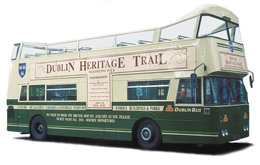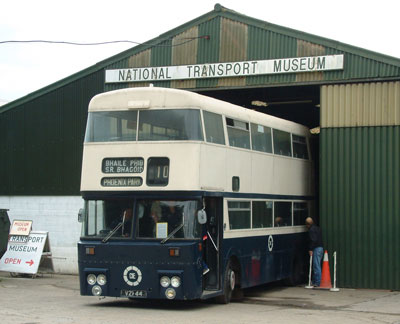|
 |
Looking every day at the same familiar vehicles that seem to have been around for as long as you can remember, it is hard to imagine that one particular type literally turned design concepts back to front over forty years ago. The concept began with two experimental Leyland rear engined double-deckers, prophetically called Lowloaders, in the early fifties. Following trials with a more radical prototype known as the Atlantean and unveiled at the 1956 Earls Court Commercial Motor Show, the model went into production, Wallasey Corporation being the first operator of the type in 1958.
Almost overnight, the Atlantean made the traditional, tried and trusted front-engined, rear platform double-decker obsolete — well, nearly. The world's biggest bus operator, London Transport, was not impressed, nor were several others, including CIE. Nevertheless, over the next few years, demonstrators visited most large operators, including CIE which ran one for several months in 1960. CIE engineers were still not convinced that this was the ideal bus; during the next five years they tried a Guy Wulfrunian and placed 26 traditional style double-deckers in service while they agonised about the Atlantean.
In a final effort to convince CIE and keep the rival Daimler Fleetline from gaining a foothold, Leyland sent over three more demonstrators, borrowed from Bolton, Glasgow and Liverpool, in 1964. As a result, a massive order for 341 Atlanteans was placed by CIE. Because many Atlanteans in Britain presented a box-like and utilitarian appearance, CIE put much effort into producing a body design that would be distinctive and durable. The company was even then concerned with growing traffic congestion and the necessity to retain passengers by running attractive buses.
CIE's Atlantean chassis were imported completely knocked down and assembled at Broadstone. Body framing by Metal Sections was similarly dealt with and mounted on the chassis which were then driven to the Spa Road factory in Inchicore, recently demolished. There, the bodywork was completed and the first of the buses that would become an integral part of the street scene in our towns for nearly thirty years, emerged in October 1966. Up to 1974, a total of 602 Spa Road Atlanteans was built. Designated the D class, those up to D218 were front-entrance 78-seaters, the remainder being dual-door 74-seaters. The last eighty or so were built under the aegis of Van Hool-McArdle, who took over the Spa Road Works in 1973.
The first Atlanteans, model PDR1, were powered by the Leyland O.600 engine of 9.8 litres, driving through a semi-automatic gearbox. These buses were certainly under-powered and later vehicles had the larger O.680 engine, which improved performance considerably. Atlanteans also experienced problems in the engine cooling and transmission departments, leading to several modifications over the years. Compounding the problems, Leyland's hitherto impeccable quality and customer service standards also slipped in the early seventies.
In time, a revamped model known as the AN68 was offered and bought by CIE, but that is another story. But in the end, despite their chequered and sometimes unhappy history, the last Spa Road or MetSec Atlanteans were not withdrawn from service until 1995 and several of them were still working in the open-top tours fleet in the Spring of 1999. They were the subject of so many experiments and modifications during their working lives that by the time they were withdrawn, most of them differed significantly from their original condition. Another curious fact is that not all of the six hundred and two worked at the same time — through accidents and arson, some had very short lives, one bus being destroyed in a fatal fire only six weeks joining the fleet.
The Transport Museum were lucky in being able to acquire, in 1986, a reasonably original MetSec Atlantean in the form of D44 (VZI 44). This bus, which is in excellent mechanical condition, came in the mercifully short-lived tan livery but was later returned to its original blue and cream colour scheme. In 1995, it was used in the Ferdia Mac Anna film Last of the High Kings. This exercise brought home forcibly how completely our streetscapes change over very short periods.
|
|

